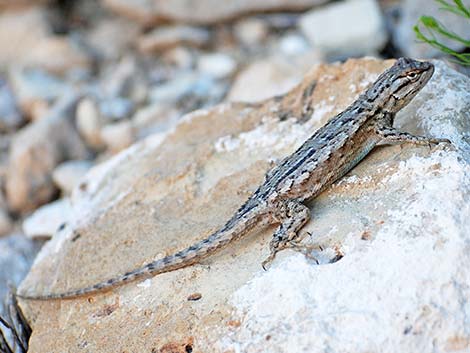
aka Sagebrush Lizard (Sceloporus graciosus)
Lizards Around Las Vegas, Wildlife Around Las Vegas
 Northern Sagebrush Lizard |
General Description: Northern Sagebrush Lizards (Sceloporus graciosus graciosus) are the common little (5-6 in. total length) gray or tan lizards in sagebrush and mountainous areas with light dorsal stripes and blue bellies. These are "spiny lizards" and look similar to Western Fence Lizards, but the scales are relatively small and smooth compared to other "spiny lizards." The armpits are rust colored, they have white behind the legs (not yellow or orange). Males have light blue belly and throat patches. The ventral color is light tan or cream (not dark gray). Taxonomy: Phrynosomatid Lizard Family (Phrynosomatidae). Technical Description: Size small; head and body 2- to 2.5-inches. Base color gray or brown. Dorsum with darker blotches or crossbars; light gray or tan stripe running down the center of the back, plus two light stripes, one running down each side of the back. Shoulder with black line. Armpit, neck, and sides of body with rusty red. Dorsal scales weakly keeled, pointed. Rear and underside of legs white (not yellow or orange). Dorsal scales numerous, small, spiny (scale count between interparietals and rear of the thigh is 42-68). Scales on rear of thighs mostly granular; femoral pores present. |
 Dorsal scales uniform in size (Compare with tree lizard) |
Males: Enlarged postanals. Base of tail swollen. Ventral patches blue edged with black. Throat patch light blue with white or pink flecks. Dorsal scales with blue-green flecks. Females: Little or no blue on the belly and throat. Diet: Beetles, flies, ants, caterpillars, aphids, other insects and spiders, ticks, and mites. Habitat: Primarily middle and higher elevations in our area. Occurs with Side-blotched Lizards and Western Fence Lizard at higher elevations. As their name implies, Sagebrush Lizards are predominately found in sagebrush habitats, but they can also be found in greasewood and other desert shrubs and sometimes on small rocky outcrops. Sagebrush Lizards are usually found at higher elevations than Western Fence Lizards and may even be found in pinyon-juniper woodlands with brushy understory. Ground dweller. Uses rodent burrows, shrubs, logs, and similar places for cover. |
 Dorsal pattern is variable with stripes and irregular spots |
Range: These are lizards of sagebrush country, occurring from eastern Washington to Wyoming, south to southern Nevada in the Spring Mountains, Northern Arizona, and northwestern New Mexico. I know of several observations in the Spring Mountains of southern Nevada, which is farther south than they are expected based on published range maps. Breeding: Mate in the spring and lay 2-7 eggs from June to August. Eggs hatch in August. Similar Species: Western Fence Lizard: larger size, scales keeled; ventral surfaces of legs yellow to orange (not white); armpits, sides of body without rust color. Comments: |
 Not always present, note black bar on shoulder |
 Not always present, note black bar on shoulder |
 The color behind the leg is white (not yellow or orange) |
 The color behind the leg is white (not yellow or orange) |
 Breeding male on Mt. Charleston |
 Breeding male |
 Breeding male |
 Breeding male with swollen hemipenes |
 Female, Mt Charleston, Hilltop Campground |
 Female, Mt Charleston, Spring Mountains Visitor Center |
 |
 |
 |
 |
 Sagebrush lizard and sagebrush |
 Typical view: sagebrush lizard on lookout post |
 Male courting female |
 Male puffed up showing belly colors to female |
Note: All distances, elevations, and other facts are approximate.
![]() ; Last updated 231212
; Last updated 231212
| Lizards Around Las Vegas | Wildlife Around Las Vegas | Glossary | Copyright, Conditions, Disclaimer | Home |